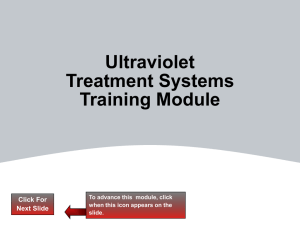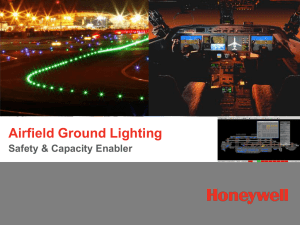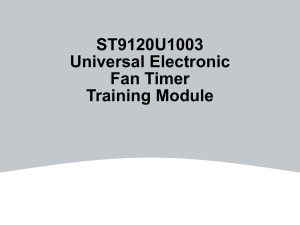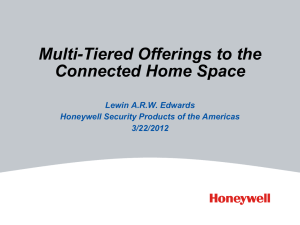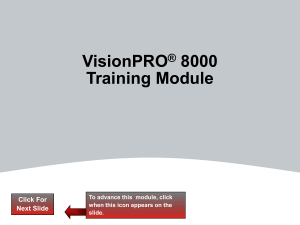Designing a Gas Detection System
advertisement
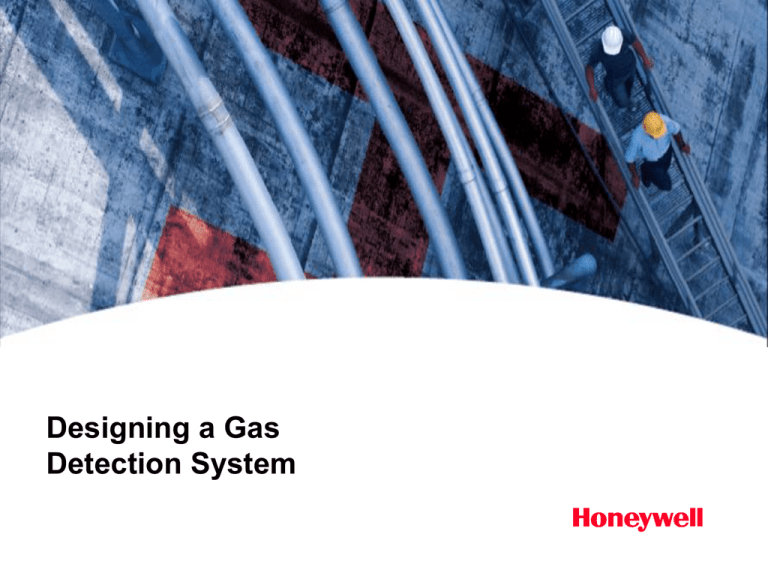
Designing a Gas Detection System Honeywell.com Why Gas Detection? • Safeguard Life and Property. – Provide Early Warning of Hazardous Conditions. – Provide Opportunity for Evacuation and Notification from Re-entry – Provide Time for Intervention and Correction. • Trigger Facility Protection Systems. – • • • 2 Ventilation, Water Mist, Fire Suppression. Satisfy Local Fire Code and Provide Insurability. Address Real and Perceived Safety Concerns. Note: Gas Detection is “Recommended Practice,” “Required by Code,” or “Required by Law.” Honeywell Proprietary Honeywell.com Points to Consider • • • • • • • Understand the application Identify potential danger points Establish design goals Determine gas characteristics Profile the plant and potential release scenarios Other elements in selecting gas detection systems Actual placement of detection – Indoors – Outdoors 3 Honeywell Proprietary Honeywell.com Understand The Application • The gases to be monitored – – – – Toxic (STEL, TLV, TWA) Combustible (LEL, UEL) Exposure limits Density and Other Gas Properties • Local and federal regulations – Uniform Fire Code – Code of Federal Regulations – Local Fire Marshal 4 Honeywell Proprietary Honeywell.com Identify Potential Danger Points – Release Points – sensors should be placed as close as possible to potential leak sources. – – – – – – Seals and flanges, fittings and welds Expansion joints and gaskets Engine combustion Storage, loading and unloading areas Runoff areas Decomposing materials – Receptor Points – a gas detection notification system should protect any person, property or equipment that may come in contact with harmful gases. – – – – – 5 Wind direction Ventilation systems Run off areas Confined spaces Communities and facilities Honeywell Proprietary Honeywell.com Establish Design Goals Initiate a response based on an early warning of a potential problem. Notification or annunciation – method of warning Ventilation control Process shutdown Evacuation and emergency response Amount of confinement - over pressurization and accumulation Run-up distance – speed of flame increases with distance Amount of congestion or obstacles Fuel quantity and mixing Margin of safety – distance between leak source and receptors Plant safety process Insurance requirements 6 Honeywell Proprietary Honeywell.com Determine Gas Characteristics • LEL, UEL, Toxicity • Vapor density – Density differences with temperature • Cryogenic liquids, flammable liquids – Low density gases displacing ambient density gases (helium vs. oxygen) – Gases under pressure will condense in areas where vented first • Gases changing composition – dry ice • Toxicity vs. flammability (MTBE 40 PPM 1.6% LEL) • Hydrolyzed (BF3, F2) • Pyrolyzed (NF3) • Flash point - the lowest temperature at which a liquid can form an ignitable mixture in air near the surface of the liquid. The lower the flash point, the easier it is to ignite the material. • Rate of evaporation and dispersion characteristics • Gas mixing (fuel, oxygen, ignition source) • Oxygen enriched environments 7 Honeywell Proprietary Honeywell.com Gas Hazards There are three main types of gas hazard 1. Flammable – Risk of fire and or explosion, e.g. Methane, Butane, Propane 2. Toxic – Risk of poisoning, e.g. Carbon Monoxide, Hydrogen Sulfide, Chlorine 3. Asphyxiant – Risk of suffocation, e.g. Oxygen deficiency, Nitrogen, Carbon Dioxide 8 Honeywell Proprietary Honeywell.com Flammable Risk • Fire Triangle Three factors are always needed to cause combustion: FIRE 1. A source of ignition 2. Oxygen 3. Fuel in the form of a gas or vapour fuel 9 Honeywell Proprietary Honeywell.com Flammable Risk • The operation of a car’s choke illustrates an important part of flammable gas hazards • All flammable gases are only ignitable over their flammable range • Flammable gases tend to be measured in percentage of their explosive Limit (%LEL) 100% v/v gas 0% v/v air too rich flammable range U.E.L. (upper explosive limit) L.E.L. (lower explosive limit) too lean 0% v/v gas 100% v/v air 10 Honeywell Proprietary Honeywell.com Toxic Risk • Some gases are poisonous and can be dangerous to life at very low concentrations. • Some toxic gases have strong smells like the distinctive ‘rotten eggs’ smell of H2S • Others are completely odourless like Carbon Monoxide 11 Honeywell Proprietary Honeywell.com Toxic Risk • The measurement most often used for the concentration of toxic gases is parts per million (ppm). • For example 1ppm would be equivalent to a room filled with a total of 1 million balls and 1 of those balls being red. The red ball would represent 1ppm. 1 million balls 1 red ball 12 Honeywell Proprietary Honeywell.com Profile the Plant and Potential Release Scenarios Gas sensors should be placed to ensure that a quantity of gas will past by them in all normal release scenarios. • • • • • • 13 Identify physical features of plant Identify ventilation tracks Identify escape routes Protect entrances to areas Mark escape routes Identify wind directions Honeywell Proprietary Honeywell.com Other Elements • • • • • • • Accessibility for calibration and maintenance Wiring and installation Environmental conditions EMI and RFI Alarm levels Exposure limits Oxygen levels – some toxic gas electrochemical sensors require a minimum oxygen level to function. All catalytic bead combustible detectors require oxygen to work. • Be aware of poisoning and inhibiting factors 14 Honeywell Proprietary Honeywell.com Interior Detector Placement Guidelines • Operate Detectors Within their Temperature Limits. Use Sample Draw or Duct Mount Configurations When Needed • Water, Moisture, Dust and Dirt May Affect Performance. Minimize Exposure and Protect From Adverse Conditions • Locate Detectors With Respect to Grade, Floor, or Operating Level - According to Building Design, HVAC System, Characteristics of Potential Leak • When Monitoring Specific Equipment, Place Detectors Near (12 Inches) Pump, Seal, Tank, Valve, etc. • Sensitivity of Detector Depends on Proximity to Leak. Adjust Alarms if Earlier Annunciation is Required • Mount Detectors Securely, Independent of Vibration, With Weather Shield Facing Downward • Conduct Smoke Trace Behavior Studies If in Doubt 15 Honeywell Proprietary Honeywell.com Detector Spacing Indoors • There are Few Published Guidelines and No Standards Indicating Area or Volume Effectively Protected By a Diffusion Sensor. There is a Corollary in Fire Protection • UL Suggests a 900 Ft2 Ceiling Space Per Smoke Detector, Which is a 30 Ft. Square or 15 Ft. Radius • Using This Base Guideline, the Total Number of Detectors Must be Based on – Gas Dispersion Characteristics and Air Movement – Potential Leak Source Locations and Characteristics, – Sources of Ignition Locations – Interior Space Division by Walls or Barriers – Economics of the Procurement 16 Honeywell Proprietary Honeywell.com Detector Spacing Indoors, Cont’d. • UL Suggests a 900 Ft2 Ceiling Space Per Smoke Detector 15 Feet 15 Feet 30 Feet Detector Detector 30 Feet References NFPA 72 E, Standard On Automatic Fire Detectors Schaeffer, M.J., “The Use of Combustible Detectors in Protecting Facilities from Flammable Hazards,” ISA Transactions, Volume 20, No. 2, Instrument Society of America 1981 17 Honeywell Proprietary Honeywell.com Indoors 40 feet Door Ceiling Ventilation 20 ft Natural Gas S T O R A G E Lab Bench Cl2 Door LN2 Window 18 Honeywell Proprietary Honeywell.com Outdoor Detector Location Guidelines • Use same considerations outdoors as indoors. • Consider Angle and Direction of Prevailing Wind • The Orientation of Structures and Surrounding Terrain with Regard to Shielding Affects • The Proximity of Large Quantities of Toxics to Personnel and Equipment, Which May Require Added Detectors to Isolate the Two 19 Honeywell Proprietary Honeywell.com Outdoor Detector Location Guidelines Possible Entrapment of Leaking Gases and Vapors Within Columns, Low Lying Areas or Confined Spaces Sources of Ignition and Processes With Fugitive Leak Potential Are Considered for Detector Placement 20 Honeywell Proprietary Honeywell.com Outdoor Detector Location, Cont’d. • Heavier Than Air Gases or Vapors: Vapor Density >1 – The Preferred Location for Detectors is ~18 Inches Above Grade. For Liquid Spills, As Close to the Vapor/Liquid Interface as Possible, and Still Allow for Detector Calibration • Lighter Than Air Gases and Vapors: Vapor Density <1 – The Preferred Location for Detectors is About 6 to 8 Feet Above Grade or Operating Level, With Special Attention Being Paid to Air Currents, Structures, Roofed Areas, Etc. 21 Honeywell Proprietary Honeywell.com Detector Spacing Outdoors • Few Guidelines Exist for Detector Placement • An Increased Grid Density is Used Outdoor Presumably Because of the Greater Potential for Leak Dilution • Thus, More Detectors Are Required, and Potential Leaks Are Encircled, to Account for Wind Shifts 22 Honeywell Proprietary Honeywell.com Detector Spacing Outdoors Repeat Outdoor Grid Pattern as Conditions Warrant. Focus on Potential Leak Sources for Additional Detectors if Required Detector 10-15 Feet Detector 10-15 Feet 20-30 Feet 20-30 Feet 23 Honeywell Proprietary Honeywell.com General Location Considerations • Toxic Gases and Vapors: – Identify Potential Leak Sources, Work Areas, and Exit Points. Understand Where People are Performing Their Work and Place Detectors Between Probable Release Points and the Work Area 24 Honeywell Proprietary Honeywell.com General Location Considerations • Allow Access for Sensor Calibration and Replacement. – Sensors Have a Finite Life - Calibrate and Maintain Regularly! • Always Locate Detectors Using “Local Conditions Knowledge,” and Lighter or Heavier Than Air Principles 25 Honeywell Proprietary Honeywell.com General Location Considerations • Locate Detectors Within Their Temperature Rating – Avoid Exposure to Sources of High Radiant Heat • Keep Detectors Away From Moisture and Chemicals – Avoid Vibration and Mechanical Shock Hazards • Observe Recommended Wiring and Tagging Practices • Use Shielded Cable Whenever Possible and Follow Correct Grounding Practices (NFPA 70) • Observe Proper Detector Mounting Orientation 26 Honeywell Proprietary Honeywell.com Detector Location and Area Coverage Map IMPORTANT Detectors should be located close to any potential leak source and between leak source and any potential source of ignition existing at the monitored site. XNX-Optima FILL LINE DETECTOR LOCATED ON TOP OF TANK NEAR VALVE OR FLANGE ON FILL LINE FILL LINE TANK SUPPORT LEGS TOP VIEW OF STORAGE TANK OUT FLOW SIDE VIEW OF STORAGE TANK 27 DETECTORS SHOULD BE LOCATED BELOW TOP OF DYKE WALL FOR VAPORS THAT ARE HEAVIER THAN AIR. Sensor should be approx 12-18 in above grade. These vapor densities are greater than air. Honeywell Proprietary TOP VIEW OF STORAGE TANK Honeywell.com Detector Location and Area Coverage Map IMPORTANT Detectors should be located close to any potential leak source and between leak source and any potential source of ignition existing at the monitored site. XNX-Optima FILL LINE DETECTOR LOCATED ON TOP OF TANK NEAR VALVE OR FLANGE ON FILL LINE FILL LINE TANK SUPPORT LEGS OUT FLOW SIDE VIEW OF STORAGE TANK 28 DETECTORS SHOULD BE LOCATED BELOW TOP OF DYKE WALL FOR VAPORS THAT ARE HEAVIER THAN AIR. Sensor should be approx 12-18 in above grade. These vapor densities are greater than air. Honeywell Proprietary Honeywell.com Detector Location and Area Coverage Map IMPORTANT: This is intended as a General Application Note and NOT as the sole source of information in determining quantity and location for detector placement. Consult additional resources when developing a monitoring system. Additional information is available for developing Combustible Gas Detection systems, such as: The National Fire Protection Association, NFPA 52 and the Instrument Society of America, ISA-RP12.13-Part II-1987. Services are also available from Professional Safety Engineering Firms and should be utilized whenever necessary TOP VIEW OF THREE AND TWO TANK AREA SIDE VIEW OF TANK 8 4 5 6 DETECTORS SHOULD BE LOCATED BELOW TOP OF DYKE WALL FOR VAPORS THAT ARE HEAVIER THAN AIR. Sensor should be approx 12-18 in. above grade.. 7 IMPORTANT Detectors should be located close to any potential leak source and between leak source and any potential source of ignition existing at the monitored site. 29 Honeywell Proprietary Honeywell.com Detector Location and Area Coverage Map TOP VIEW OF UNLOADING FACILITY R.R. SPUR NO. 13 R.R. SPUR NO. 12 IMPORTANT Detectors should be located close to any potential leak source and between leak source and any potential source of ignition existing at the monitored site. NOTE: IF PIPING FUNCTIONS OR VALVES ARE ABOVE THE TANK CAR A DETECTOR MAY BE MOUNTED PART WAY DOWN THE WALL TO DETECT FALLING VAPORS FROM A LEAK SOURCE I I I I NOTE: DETECTORS SHOULD BE LOCATED LOW, CLOSE TO GRADE FOR VAPORS THAT ARE HEAVIER THAN AIR. NOTE: Sensor should be approx. 12-18 in. above grade. These vapor densities are heavier than air. SIDE VIEW OF UNLOADING FACILITY 30 Honeywell Proprietary Honeywell.com Publications to Reference • Chemical Weekly, 2008, “Key Considerations when Designing a Gas Detection System” • ISA Recommended Practices • ACGIH: Annual TLV and BEI Guide – 1330 Kemper Meadow Drive, Cincinnati OH 45240-1634 • NFPA/ANSI Guides, Standards and Practices – 1 Batterymarch Park, Quincy MA 02269-9101 • NIOSH: Pocket Guide to Chemical Hazards – Available by FAX Request to (513) 533-8573 • OSHA, CFR 29, Section 1910.1000, Subpart Z“Working in Confined Spaces.” – NIOSH1 Publication 80-106 • “A Guide to Safety in Confined Spaces.” – NIOSH Publication 87-113 • “ALERT: Request for Assistance in Preventing Occupational Fatalities in Confined Spaces.” – NIOSH Publication 86-110 31 Honeywell Proprietary Honeywell.com The End Questions? 32 Honeywell Proprietary

